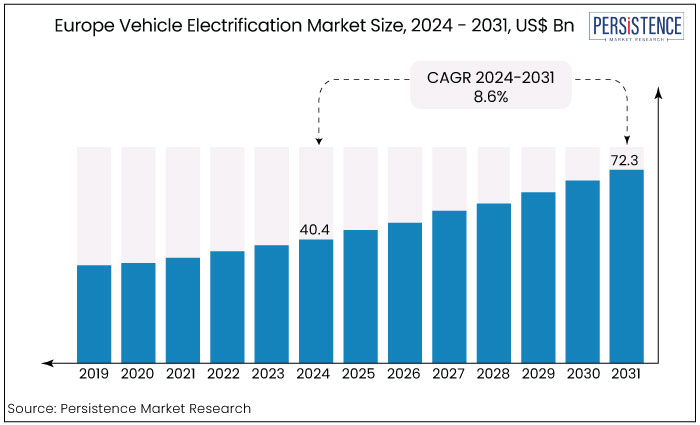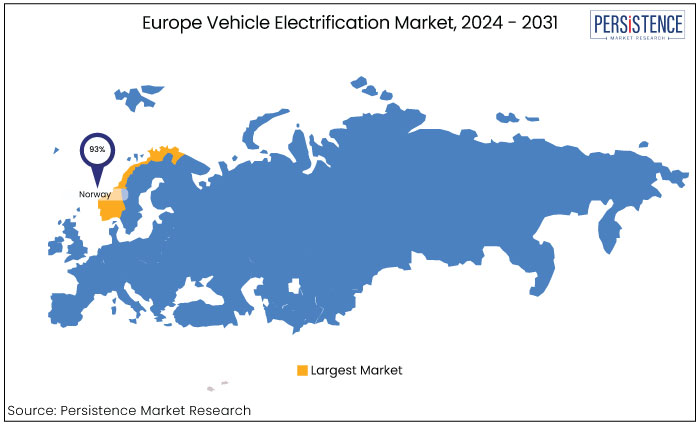Industry: Automotive & Transportation
Published Date: October-2024
Format: PPT*, PDF, EXCEL
Delivery Timelines: Contact Sales
Number of Pages: 166
Report ID: PMRREP34866
Europe vehicle electrification market is estimated to increase from US$40.4 Bn in 2024 to US$72.3 Bn by 2031. The market is projected to record a CAGR of 8.6% during the forecast period from 2024 to 2031. The market expands due to consumer demand, and investment in charging infrastructure. Expanding charging infrastructure and OEM investments fuel this transition, advancements in battery technology, and power electronics contribute to industry growth.

Key Highlights of the Market
|
Market Attributes |
Key Insights |
|
Europe Vehicle Electrification Market Size (2024E) |
US$40.4 Bn |
|
Projected Market Value (2031F) |
US$72.3 Bn |
|
Global Market Growth Rate (CAGR 2024 to 2031) |
8.6% |
|
Historical Market Growth Rate (CAGR 2019 to 2023) |
5.3% |
Europe is at the forefront of the vehicle electrification market due to a combination of strong regulatory frameworks, significant consumer demand, and extensive investment in charging infrastructure. The European Union has implemented stringent emissions regulations, pushing automakers to accelerate their transition to electric vehicles (EVs). In 2022, electric vehicles accounted for 21.6% of new car registrations in the EU, reflecting a rapid increase in consumer acceptance and preference for sustainable transportation options.
Norway contributes to the growth of Europe's vehicle electrification market, with an impressive share of electric vehicle (EV) sales reaching 93%. Moreover, European governments offer various incentives, such as tax breaks and subsidies, to encourage EV adoption. This supportive environment and a growing network of charging stations facilitate the shift from traditional internal combustion engine vehicles to electric alternatives. As a result, Europe is leading in market share and setting a global benchmark for vehicle electrification initiatives.

Electric power steering (EPS) is poised to become a leading segment in the vehicle electrification market. This innovative technology not only enhances vehicle maneuverability but also significantly cuts down fuel consumption making it a preferred choice for modern automobiles. In regions like Europe, nearly every vehicle is now equipped with EPS showcasing its widespread acceptance.
Notable segment growth indicates a strong shift toward electrification in this area reinforcing the expectation that the EPS segment will command the largest market share throughout the forecast period. It further shapes the future of automotive engineering and sustainability.
Plug-In hybrid electric vehicles (PHEVs) are currently the significantly growing segment in the automotive market. Many automakers view PHEVs as a crucial stepping stone toward fully electric vehicles bridging the gap between traditional internal combustion engine (ICE) models and electric alternatives.
Expanding charging infrastructure in European countries is a significant factor driving this transition. As these regions enhance their charging networks, the shift from conventional ICE vehicles to PHEVs is expected to accelerate.
Substantial investments made by Original Equipment Manufacturers (OEMs) in these markets in vehicle electrification are further fueling the demand for PHEVs underscoring a significant movement toward sustainable transportation solutions in the automotive industry.
The Europe vehicle electrification market analysis encompasses the adoption of electric vehicles (EVs), hybrid electric vehicles (HEVs), and plug-in hybrid electric vehicles (PHEVs) as alternatives to traditional internal combustion engine (ICE) vehicles. This market operates through the integration of electric drivetrains, battery technology, and charging infrastructure enabling the transition to clean solutions.
The primary uses of vehicle electrification include reducing greenhouse gas emissions, enhancing energy efficiency, and providing consumers with cost-effective transportation options. As countries in Europe enforce strict emissions regulations and promote sustainable mobility, vehicle electrification is increasingly seen as a pivotal solution for achieving environmental goals and fostering energy independence.
The European Union's ambitious climate targets significant investments in renewable energy, and enhanced government incentives aimed at promoting electric mobility. Additionally, one of the Europe vehicle electrification market trends like the introduction of new EV models and improvements in charging technologies will likely to boost consumer adoption.
As automakers increasingly pivot toward electric solutions, the landscape of the vehicle electrification market in Europe is set to evolve significantly positioning it as a cornerstone of the region's sustainable transport future.
Europe vehicle electrification experienced a CAGR of 5.3% during the forecast period from 2019 to 2023. This growth can be attributed to increasing regulatory pressures to reduce carbon emissions, rising fuel prices, and a growing consumer preference for sustainable transportation options.
Factors such advancements in battery technology and the expansion of charging infrastructure have further supported market growth making electric vehicles (EVs) appealing to consumers. The market is projected to accelerate significantly with an anticipated CAGR of 8.6% during the period from 2024 to 2031.
Market surge is driven by technological advancements, government incentives, and changing consumer preferences. The trend toward sustainability is prompting manufacturers to invest significantly in battery technology and electric drivetrains resulting in improved vehicle performance and reduced costs.
The expansion of charging infrastructure across urban and rural areas is alleviating range anxiety making EVs accessible to consumers. Furthermore, collaborations between automakers and tech companies are fostering innovation in autonomous driving and smart mobility solutions. As a result, the market is not only poised for expansion but is also evolving to meet the diverse needs of environmentally conscious consumers.
Regulatory Framework and Government Incentives Remains a Key Driver
One of the primary growth drivers in the Europe vehicle electrification market is the robust regulatory framework and supportive government incentives aimed at reducing greenhouse gas emissions. The European Union has set ambitious targets to achieve carbon neutrality by 2050, leading to stringent regulations on internal combustion engine vehicles.
Governments across member states are implementing various incentives, such as tax breaks, subsidies, and grants for electric vehicle purchases, making them more financially accessible to consumers. Additionally, many countries are investing in charging infrastructure, enhancing the convenience of owning an electric vehicle. This combination of regulatory pressure and financial support encourages manufacturers to innovate in the electrification space and motivates consumers to transition to electric mobility.
Technological Advancements Propel the Market
Technological advancements are propelling the Europe vehicle electrification market expansion. Innovations in battery technology, such as improved energy density and fast charging capabilities have made electric vehicles practical and appealing to consumers. Manufacturers are investing significantly in research and development to enhance battery performance extend driving ranges and reduce costs.
Advancements in electric drivetrains and power electronics are contributing to the overall efficiency and performance of electric vehicles. The emergence of new technologies such as solid-state batteries and wireless charging is also set to transform the market landscape. As these technologies mature, they will likely to lead to a broad adoption of electric vehicles, driving growth in the electrification market.
Changing Consumer Preferences
Shifting consumer preferences towards sustainable and environment-friendly transportation options are another key driver of the Europe vehicle electrification market growth. As awareness of climate change and environmental issues rises, consumers are increasingly seeking alternatives to traditional gasoline and diesel vehicles. The desire to reduce their carbon footprint has led many to consider electric vehicles as a viable option.
The perception of electric vehicles has improved significantly, with advancements in technology addressing concerns about performance, range, and charging time. Car manufacturers are also responding to these changing preferences by offering a diverse range of electric models that cater to various consumer needs, from compact cars to SUVs. This growing demand for sustainable transportation solutions is fueling the expansion of the vehicle electrification market.
Insufficient Charging Infrastructure
Another critical factor hindering the Europe vehicle electrification market growth is the insufficient charging infrastructure. While there has been progress in expanding charging networks, many regions still lack adequate access to charging stations particularly in rural areas. This limitation creates range anxiety among potential EV buyers who may worry about the availability of charging options during long trips.
The inconsistency in charging standards and the slow rollout of fast-charging stations can exacerbate these concerns. Only when a comprehensive and reliable charging infrastructure is established, consumer adoption of electric vehicles remains constrained.
High Initial Costs Remains a Significant Market Restraining Factor
One of the significant factors impeding the Europe vehicle electrification market is the high initial cost of electric vehicles (EVs). Despite decreasing battery prices, the upfront cost of EVs remains higher than that of traditional internal combustion engine vehicles. This price disparity can deter potential buyers, particularly in segments where consumers are price-sensitive.
While government incentives can help offset these costs, they may not be sufficient to make EVs competitive for all consumers. As a result, the perceived financial burden continues to limit widespread adoption of electric vehicles across Europe.
Rising Charging Infrastructure
One of the most promising future opportunities for the Europe vehicle electrification market lies in the expansion of charging infrastructure. Increasing investments from both public and private sectors aim to build a robust network of charging stations across urban and rural areas. The introduction of fast charging technologies and innovative solutions like wireless charging can enhance the convenience of EV ownership, alleviating range anxiety for consumers.
Integrating charging stations into existing infrastructure, such as shopping centers, workplaces, and residential areas, can promote EV adoption. With the European Union prioritizing sustainable mobility, a comprehensive charging ecosystem will not only facilitate the transition to electric vehicles but also create job opportunities and stimulate economic growth in related sectors.
Development of Advanced Battery Technologies
Another significant opportunity in the Europe vehicle electrification market is the development of advanced battery technologies. Innovations such as solid-state batteries, which promise higher energy density, faster charging times, and improved safety, could revolutionize the electric vehicle landscape.
Research and development initiatives aimed at enhancing battery lifespan and sustainability can also contribute to greater consumer confidence and adoption. Furthermore, as European manufacturers increasingly focus on localizing battery production to reduce reliance on imports, this can foster economic growth and job creation within the region. By investing in cutting-edge battery technologies, Europe can position itself as a leader in the global EV market, driving further electrification and innovation in transportation.
The competitive landscape of the Europe vehicle electrification market is marked by significant innovation and strategic partnerships among key players. For instance, Volkswagen has made substantial strides with its ID.4 and ID. Buzz electric models launched in 2022 showcasing advanced battery technology and enhanced driving range.
Tesla continues to lead with its Model Y and Model S Plaid, offering cutting-edge features like autopilot and superior performance metrics. These companies exemplify the dynamic competition and continuous innovation driving the electrification of the automotive sector in Europe.
Recent Developments in the Europe Vehicle Electrification Market
|
Attributes |
Details |
|
Forecast Period |
2024 to 2031 |
|
Historical Data Available for |
2019 to 2023 |
|
Market Analysis |
US$ Billion for Value |
|
Key Countries Covered |
|
|
Key Market Segments Covered |
|
|
Key Companies Profiled |
|
|
Report Coverage |
|
|
Customization & Pricing |
Available upon request |
By Product Type
By Degree of Hybridization
By Countries
To know more about delivery timeline for this report Contact Sales

The market is predicted to rise from US$40.4 Bn in 2024 to US$72.3 Bn by 2031.
Some of the leading industry players in the market are Volkswagen, Tesla, Toyota, and Continental AG.
The market is projected to record a CAGR of 8.6% during the forecast period from 2024 to 2031.
Electric power steering remains a top product type in the market.
Innovations in battery technology remains a key opportunity for the market players.